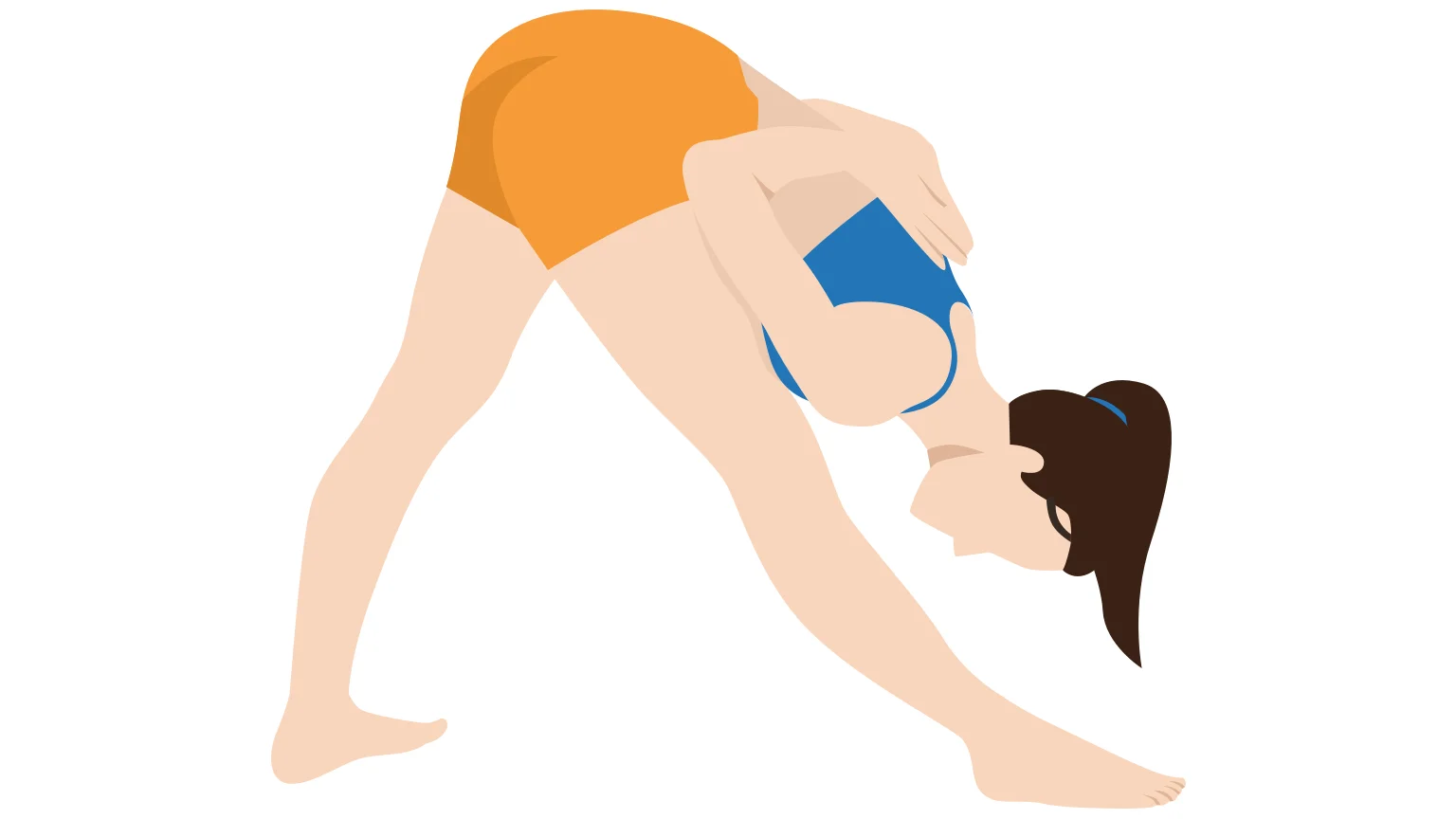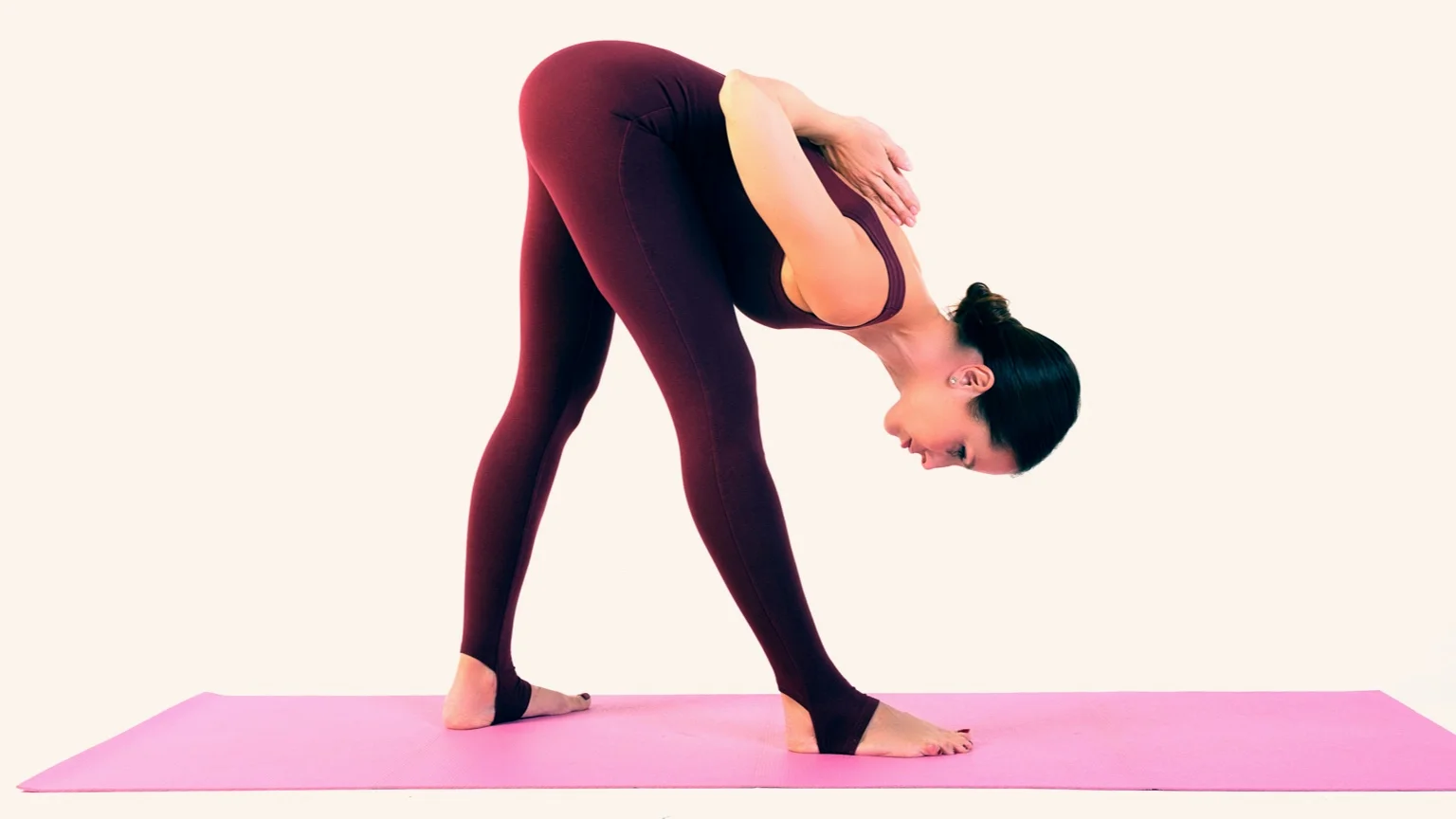
The Intense Side Stretch Pose, also known as The Pyramid Pose or Parsvottanasana is a standing yoga pose. In this pose, with one foot extended forwards and the other back, you fold your upper body at your hips over your extended leg. Your arms reach behind your back and your hands are brought together in the ‘praying’ position.
- Position: Standing.
- Stretched body parts: The Intense Side Stretch Pose primarily stretches your hamstrings, quads, glutes, hip and spine. It also stretches your shoulders and wrists as you bring your hands together behind your back.
- Benefits: This pose is great for stretching the muscles in your legs, helping you build up strength and flexibility. As a standing pose, it can help you develop your balancing skills and improve your overall stability. By compressing your abdomen, this pose can also help improve digestion.
- Symbolism: The pose forms a triangle which symbolizes a pyramid shape. Just as the Pyramids have withstood the test of time, this pose symbolizes the need to build a solid and stable foundation in one’s life.
- Similar poses: Wide Legged Forward Bend (Prasarita Padottanasana), Standing Forward Bend (Uttanasana), and Downward-Facing Dog (Adho Mukha Svanasana).
Meaning of Parsvottanasana
The name “Parsvottanasana” is derived from four Sanskrit words:
- “Parsva” means “side” or “flank”;
- “Ut” means “intense”;
- “Tan” means “to stretch” or “to extend”; and
- “Asana” means “pose”.
Together, we get the word “Parsvottanasana” which translates literally to mean “Intense Side Stretch Pose”. As you position yourself into the pose, there is a stretch along the side of your body.
The pose is often called The Pyramid Pose due to its resemblance to the shape of a pyramid. In the final position, your body forms a triangle with your hip opened and body aligned along one of your legs.
The pyramid shape symbolizes stability and a firm grounding, just as the Pyramids have withstood the test of time due to their solid construction. At the same time, this pose requires a lot of flexibility, so it’s a pose that hints at the need for both stability and flexibility in one’s life.
How to do The Intense Side Stretch Pose

- Start in a standing position, with your feet hip-width apart and pointing forwards (parallel to each other). Keep your arms by your sides and your gaze straight ahead.
- Step your feet 3-4 feet apart and turn your right foot out 90 degrees. Turn your left food in slightly to the right.
- Take a deep breath. Then, as you exhale, rotate your torso so your hip points are aligned with the front of your yoga mat.
- Inhale and relax your spine and shoulders.
- Now, exhale and hinge over at your hips over the front-positioned leg. Bend as far as your can towards your leg.
- Stay in the pose for 30-60 seconds, taking a number of breaths.
- Now, inhale and return back to the starting position. Reverse the position of your feet and repeat the pose on your other side.
Variations
- For extra support: If needed, use a wall to support your back foot. This can help prevent your foot slipping and make it easier to maintain balance.
- Use a chair for support: If you find it difficult to maintain balance, consider using a chair you can reach out to hold for support, rather than reaching your hands behind your back.
- More challenging: To stretch even further, you can try lifting the heel of the foot you have positioned forward. This small variation will demand more balance and control.
Tips
- It’s okay to round your back slightly as your get deep into the pose. This will help you reach behind your back if you try to clasp your hands together into the ‘praying’ position.
- Be sure to engage your core to support your back as you bend forwards.
- Keep your gaze focused on your foot. This can help you maintain balance and may be a more comfortable position for your neck as you bend deep into the pose.
Prep poses
- Downward-Facing Dog (Adho Mukha Svanasana) – This pose stretches your hamstrings and calves, but requires less balance compared to the Intense Side Stretch Pose.
- Wide Legged Forward Bend (Prasarita Padottanasana) – This pose requires flexibility and strength in your hamstrings and hips, making it a great prep pose for the Intense Side Stretch Pose. It also encourages the lengthening of your spine.
- Extended Triangle Pose (Utthita Trikonasana) – The Extended Triangle Pose is another standing pose that opens up your hips, which can help in similar poses. It also stretches your hamstrings in a similar way.
